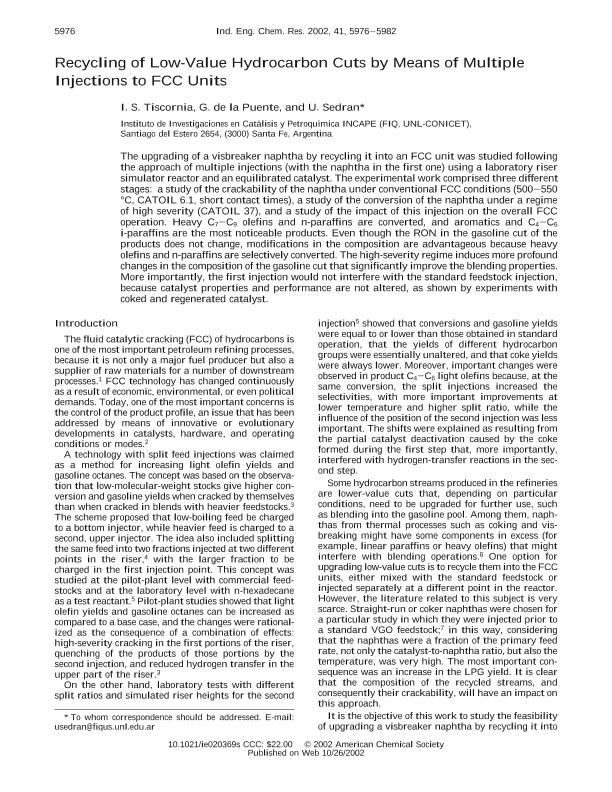Mostrar el registro sencillo del ítem
dc.contributor.author
Tiscornia, Ines Silvia

dc.contributor.author
de la Puente, Gabriela

dc.contributor.author
Sedran, Ulises Anselmo

dc.date.available
2018-04-05T20:08:57Z
dc.date.issued
2002-11
dc.identifier.citation
Tiscornia, Ines Silvia; de la Puente, Gabriela; Sedran, Ulises Anselmo; Recycling of Low-Value Hydrocarbon Cuts by Means of Multiple Injections to FCC Units; American Chemical Society; Industrial & Engineering Chemical Research; 41; 24; 11-2002; 5976-5982
dc.identifier.issn
0888-5885
dc.identifier.uri
http://hdl.handle.net/11336/40987
dc.description.abstract
The upgrading of a visbreaker naphtha by recycling it into an FCC unit was studied following the approach of multiple injections (with the naphtha in the first one) using a laboratory riser simulator reactor and an equilibrated catalyst. The experimental work comprised three different stages: a study of the crackability of the naphtha under conventional FCC conditions (500−550 °C, CATOIL 6.1, short contact times), a study of the conversion of the naphtha under a regime of high severity (CATOIL 37), and a study of the impact of this injection on the overall FCC operation. Heavy C7−C9 olefins and n-paraffins are converted, and aromatics and C4−C6 i-paraffins are the most noticeable products. Even though the RON in the gasoline cut of the products does not change, modifications in the composition are advantageous because heavy olefins and n-paraffins are selectively converted. The high-severity regime induces more profound changes in the composition of the gasoline cut that significantly improve the blending properties. More importantly, the first injection would not interfere with the standard feedstock injection, because catalyst properties and performance are not altered, as shown by experiments with coked and regenerated catalyst.
dc.format
application/pdf
dc.language.iso
eng
dc.publisher
American Chemical Society

dc.rights
info:eu-repo/semantics/openAccess
dc.rights.uri
https://creativecommons.org/licenses/by-nc-sa/2.5/ar/
dc.subject
Fcc
dc.subject
Recycling
dc.subject
Multiple Injections
dc.subject.classification
Otras Ingeniería Química

dc.subject.classification
Ingeniería Química

dc.subject.classification
INGENIERÍAS Y TECNOLOGÍAS

dc.title
Recycling of Low-Value Hydrocarbon Cuts by Means of Multiple Injections to FCC Units
dc.type
info:eu-repo/semantics/article
dc.type
info:ar-repo/semantics/artículo
dc.type
info:eu-repo/semantics/publishedVersion
dc.date.updated
2018-03-16T15:42:48Z
dc.journal.volume
41
dc.journal.number
24
dc.journal.pagination
5976-5982
dc.journal.pais
Estados Unidos

dc.description.fil
Fil: Tiscornia, Ines Silvia. Consejo Nacional de Investigaciones Científicas y Técnicas. Centro Científico Tecnológico Conicet - Santa Fe. Instituto de Investigaciones en Catálisis y Petroquímica ; Argentina
dc.description.fil
Fil: de la Puente, Gabriela. Consejo Nacional de Investigaciones Científicas y Técnicas. Centro Científico Tecnológico Conicet - Santa Fe. Instituto de Investigaciones en Catálisis y Petroquímica ; Argentina
dc.description.fil
Fil: Sedran, Ulises Anselmo. Consejo Nacional de Investigaciones Científicas y Técnicas. Centro Científico Tecnológico Conicet - Santa Fe. Instituto de Investigaciones en Catálisis y Petroquímica ; Argentina
dc.journal.title
Industrial & Engineering Chemical Research

dc.relation.alternativeid
info:eu-repo/semantics/altIdentifier/doi/http://dx.doi.org/10.1021/ie020369s
dc.relation.alternativeid
info:eu-repo/semantics/altIdentifier/url/https://pubs.acs.org/doi/abs/10.1021/ie020369s
Archivos asociados
